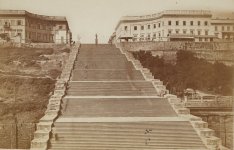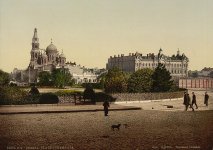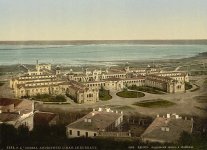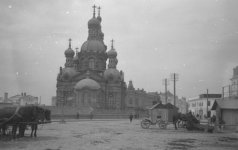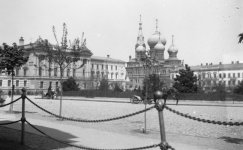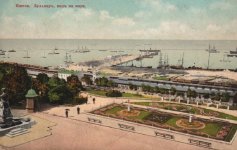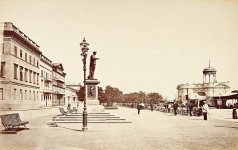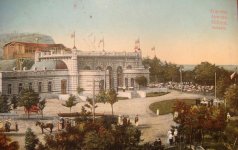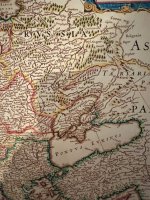The story of the city of Odessa is probably one of the most blatant historical lies we can spot. I stumbled into this entire story via a monument to Napoleon as First Consul. The monument is located on the island of Corsica.
The Google image searching algorithm suggested a few similar images, with a monument to Duke of Richelieu being one of them.

Apparently the monument to Minin and Pozharsky, and the monument to Duke of Richelieu were made by the same person, Ivan Martos. While trying to figure things out the following article came on my radar.

Duke de Richelieu and OdessaOdessa is currently a Ukrainian city. Naturally, it was interesting to figure out why they have a monument dedicated to some French dude. There it goes. Armand-Emmanuel Sophie Septimanie de Vignerot du Plessis, 5th Duke of Richelieu and Fronsac, was a prominent French statesman during the Bourbon Restoration. He was known by the courtesy title of Count of Chinon until 1788, then Duke of Fronsac until 1791, when he succeeded his father as Duke of Richelieu.

The City of OdessaHow old is Odessa in reality? Let's see if we can answer this question. Let's start with the narrative. Odessa is the third most populous city of Ukraine. Odessa is sometimes called the "pearl of the Black Sea", the "South Capital", "The Humour Capital" and "Southern Palmyra".
Odessa was the site of a large Greek settlement no later than the middle of the 6th century BC (a necropolis from the 5th–3rd centuries BC has long been known in this area). Some scholars believe it to have been a trade settlement established by the Greek city of Histria. Whether the Bay of Odessa is the ancient "Port of the Histrians" cannot yet be considered a settled question based on the available evidence.

Khadjibey came under direct control of the Ottoman Empire after 1529 as part of a region known as Yedisan after one of Nogay Hordes, and was administered in the Ottoman Silistra (Özi) Eyalet, Sanjak of Özi.

The river of DnieperWe will need the location of the mouth of this river. The Dnieper is the longest river of Ukraine and Belarus and the fourth-longest river in Europe, after Volga, Danube and Ural. The total length is approximately 2,200 km (1,400 mi). Historically, the river was an important barrier, dividing Ukraine into right and left banks.
The narrative needs to figure out what they had at Ochakov-Ochakiv, a city, or a fortress.

Battle of OchmatówOchakiv, Ochakov, Oczakow, Ochmatow, Okhmativ... this is getting somewhat comical. Now we have a village of Okhmativ (population of about 800 inhabitants). It (or its vicinity) was the site of two large battles in the 17th century:
I would call the below text a partial historical BS. Herodotus and Pliny are being talked about, like they were some ancients, but that's besides the point. What we see here is the river Bog falling into Dnieper near Oczakow. Scroll up to the 1607 map, and take a look.
Below we can see what an adjusted for its time narrative looks like. I guess stuff like this was alright for 1803. This makes the Ochakiv fortress ~2,485 years old. That's some durable construction materials right there.
Books summary: There are tons of books mentioning Oczakow on Google Ngram Viewer. There are a few where some minimal info was published about Ordessus. I did not search for other spelling versions. I have not seen Oczakow being described as some humongous city. At the same time I did not see any description of the "settlement" at all. I have no idea what the difference between a town and a city was back then.





This is one humongous "Ochakov" in the background.

Compare to ThisOn the images above we see a decent size town or city. Now compare to the below two images. I believe they suit the current narrative much better.


KD: On the top drawings of Oczakow, we can clearly see that a pretty large star city or town is being attacked. We are supposed to believe that it was today's Ochakiv. I think it was today's Odessa getting attacked and conquered.
Some Odessa facts:

Here comes the replacement. The modern building was constructed by Fellner & Helmer in neo-baroque (Vienna Baroque) style and opened in 1887.

KD's Summary: Something is not right about Odessa and its history, that's my opinion. I think it's quite probable that Odessa is a bit older than we are being told. In this case we would have something like this:
The Google image searching algorithm suggested a few similar images, with a monument to Duke of Richelieu being one of them.
- Monument to the Duke de Richelieu in Odessa
- Monument to Duke de Richelieu
- Ivan Martos's statue of the Duke of Richelieu in Odessa
- Plagiarism or provocation? Odessa Duke hides a sword in a "narrow" toga, and in Corsica - almost the same Napoleon.
- That was some interesting reading.
Duke de Richelieu and Odessa
- He was born in Paris, the son of Antoine de Vignerot du Plessis, 4th Duke of Richelieu, and of his wife, Adélaïde de Hautefort. His father was the son and heir of King Louis XV of France's favourite, Armand de Vignerot du Plessis, 3rd Duke of Richelieu (1696–1788).
- His prospects brightened, however, after Paul was murdered in 1801.
- The new Russian emperor, Czar Alexander I, was one of his friends.
- The erasure of Richelieu's name from the list of prohibited émigrés who could not legally return to France, which Richelieu on his own had previously been unable to secure from Napoleon Bonaparte, was accorded on the request of Alexander's new imperial government, and in 1803 Alexander appointed him Governor of Odessa.
- Two years later, he became Governor-general of a large swathe of land recently conquered from the Ottoman Empire and called New Russia, which included the territories of Chersonese, Ekaterinoslav and the Crimea.
- That's a huge chunk of land.
- He commanded a division in the Turkish War of 1806–1807, and was engaged in frequent expeditions to the Caucasus.
- Richelieu played a role during Ottoman plague epidemic which hit Odessa in the autumn 1812.
- In the eleven years of his administration, Odessa greatly increased in size and importance, eventually becoming the third largest city in the empire by population.
- The grateful Odessites erected a bronze monument to him in 1828.
- These are the famous Odessa Steps, crowned by a statue of Richelieu.
- Following the Bourbon Restoration (1814), he returned to his homeland and was twice Prime Minister of France.
- Governor-general in modern usage, is the title of an office-holder appointed to represent the monarch of a sovereign state in the governing of an independent realm as a viceroy.
- Governors-general have also previously been appointed in respect of major colonial states or other territories held by either a monarchy or republic.
- Russia or Muscovy?
The City of Odessa
- Before the Tsarist establishment of Odessa, an ancient Greek settlement existed at its location.
- A more recent Tatar settlement was also founded at the location by Hacı I Giray, the Khan of Crimea in 1440 that was named after him as Khadjibey.
- Khadjibey was a fortress and a haven by the Gulf of Odessa, in the location of the modern city of Odessa.
- After a period of Lithuanian Grand Duchy control, Hacibey and surroundings became part of the domain of the Ottomans in 1529 and remained there until the empire's defeat in the Russo-Turkish War of 1792.
- In 1794, the city of Odessa was founded by a decree of the Russian empress Catherine the Great.
- The city was named in compliance with the Greek Plan of Catherine the Great.
- The Greek Plan was an early solution to the Eastern Question which was advanced by Catherine the Great in the early 1780s
- It envisaged the partition of the Ottoman Empire between the Russian and Habsburg Empires followed by the restoration of the Eastern Roman Empire centered in Constantinople.
- OMG: this is such a baloney induced mambo-jumbo.
- It was named after the ancient Greek city of Odessos, which was mistakenly believed to have been located here.
- Lie #1: "ancient Greek"
- Lie #2: "mistakenly believed"
- Odessa is located in between the ancient Greek cities of Tyras and Olbia, different from the ancient Odessos's location further west along the coast, which is at present day Varna, Bulgaria.
Photographs of Odessa
Odessa is probably one of the most beautiful cities I've never been to. These are older (19th century) photographs, so I'm not sure how many of the "ancient" buildings survived the carnage of our self-destructing civilization.Odessa was the site of a large Greek settlement no later than the middle of the 6th century BC (a necropolis from the 5th–3rd centuries BC has long been known in this area). Some scholars believe it to have been a trade settlement established by the Greek city of Histria. Whether the Bay of Odessa is the ancient "Port of the Histrians" cannot yet be considered a settled question based on the available evidence.
- What is a "large" Greek settlement? Was it a camping tent, 50 camping tents, a village, a town or a small city?
- If it was a small city, why don't you historians just call it a small city then?
- Since middle of the 13th century the city's territory belonged to the Golden Horde domain.
- On Italian navigational maps of 14th century on the place of Odessa is indicated the castle of Ginestra, at the time the center of a colony of the Republic of Genoa (more Gazaria).
- At times when the Northern Black Sea littoral was controlled by the Grand Duchy of Lithuania, there existed a settlement of Kachibei which at first was mentioned in 1415. By middle of 15th century the settlement was depopulated.
- The site of present-day Odessa was then a fortress known as Khadjibey.
- "Khadzhibey" by Gennady Ladyzhensky, 1899 (he sure knew what it looked like out there)
- Plan of the fortress, 1784
Khadjibey came under direct control of the Ottoman Empire after 1529 as part of a region known as Yedisan after one of Nogay Hordes, and was administered in the Ottoman Silistra (Özi) Eyalet, Sanjak of Özi.
- In the mid-18th century, the Ottomans rebuilt the fortress at Khadjibey (also was known Hocabey), which was named Yeni Dünya (literally "New World").
- During the Russian-Turkish War of 1787–1792, on 25 September 1789, a detachment of the Russian forces, including Zaporozhian Cossacks under Alexander Suvorov and Ivan Gudovich, took Khadjibey and Yeni Dünya for the Russian Empire.
- Suvorov and Cossacks... was he their Ataman?
- Suvorov, Yermak, Pugachev, Razin and the Siberian War
- One section of the troops came under command of a Spaniard in Russian service, Major General José de Ribas (known in Russia as Osip Mikhailovich Deribas); today, the main street in Odessa, Deribasivska Street, is named after him.
- What kind of baloney is that? Spaniard José Pascual Domingo de Ribas y Boyons was known as Osip Mikhailovich Deribas. Say what?
- Russia formally gained possession of the Sanjak of Özi (Ochacov Oblast) as a result of the Treaty of Jassy in 1792 and it became a part of Yekaterinoslav Viceroyalty.
- Viceroyalty again... were those colonization type conquests?
- The newly acquired Ochakov Oblast was promised to the Cossacks by the Russian government for resettlement.
- The commander of the land forces in Ochakiv Oblast was appointed Graf (Count) Suvorov-Rymnikskiy.
- Right... who else?
- The Flemish engineer working for the empress, François Sainte de Wollant recommended the area of Khadzhibei fortress as the site for the region's basic port: it had an ice-free harbor, breakwaters could be cheaply constructed that would render the harbor safe and it would have the capacity to accommodate large fleets.
- In 1794 Catherine approved the founding of the new port-city and invested the first money in constructing the city.
- Some local historians consider that the settlement predates Odessa by about thirty years and assert that the locality was founded by Moldavians who came to build the fortress of Yeni Dunia for the Ottomans and eventually settled in the area in the late 1760s, right next to the settlement of Khadjibey (since 1795 Odessa proper), on what later became the Primorsky Boulevard.
- Another version posits that the settlement appeared after Odessa itself was founded, as a settlement of Moldavians, Greeks and Albanians fleeing the Ottoman yoke.
- Prior to it there was a fort and some Moldavian settlement there. Moldavians were not really smart back then, otherwise they would have never established a settlement right next to a constantly attacked fort.
- Oh, and some ancient Greeks had a colony there, gazillion of years ago.
- This ancient Greek colony was called Odessos. Sure enough, they wrote it down for us to inherit the name.
The city of Ochakiv
We will need this "settlement" for what follows. Ochakiv also known as Ochakov is a small city in Mykolaiv Oblast (region) of southern Ukraine.- Ochakiv (founded in 1492, right?)
The river of Dnieper
Dnieper Changed its course
In a way (and time frame) similar to the Indus river, the river of Dnieper changed its course. This major change did not happen thousands of years ago. We are talking between 1600 and 1800. Pay attention to Borysthenes and Dnieper river as we go through the maps.Ancient Odessa
I assume this is the "ancient Greek" colony of "Odessos" we are seeing on the below older maps. Of course, the information presented on these 17th century maps is not "ancient". Certain things do not change. Their lies have a pattern.- Remember: Borysthenes River = Dnieper River
- The Bog river
- The Nieper river aka the Dnieper river
- This Oczakow (Ordessus) is not the city of Ochakiv.
The narrative needs to figure out what they had at Ochakov-Ochakiv, a city, or a fortress.
- 1737: The siege of Ochakov (1737) was a siege during the Austro-Russian–Turkish War (1735–39) in which the Russian army, led by Burkhard Christoph von Münnich, captured the Ottoman fortress of Ochakov. It took place in 1737.
- LOL: Russian army, led by Burkhard Christoph von Münnich. They had no Russians in Russia?
- 1788: The second siege of Ochakov (now Ochakiv, Ukraine) was one of the major events of the Russo-Turkish War (1787–1792).
- In 1788, Russian forces led by Prince Grigory Potemkin and General Alexander Suvorov besieged the city, held by Ottoman troops commanded by Hasan Pasha.
- The Russian victory was celebrated in a famous ode by Gavrila Derzhavin, and in a Te Deum by Giuseppe Sarti.
- The city of Odessa was established in 1794, but it was not... it was already there.
- Actually Odessa was (in mass) present from about the narrative dates, but maps between 1650s and 1800 are somewhat weird.
- Please take a look for yourselves.
- Odessa = Oczakow
- Oczakow ≠ Ochakiv/Ochakov
- Examining older texts, it's important to remember that they are full of lies too.
- Fortunately for us, it is much harder to lie when your contemporaries are still alive.
- The river is believed to be the same as Ὀρδησσός Ordessus, a name mentioned by Ancient Greek historian Herodotus.
Battle of Ochmatów
I would call the below text a partial historical BS. Herodotus and Pliny are being talked about, like they were some ancients, but that's besides the point. What we see here is the river Bog falling into Dnieper near Oczakow. Scroll up to the 1607 map, and take a look.
Below we can see what an adjusted for its time narrative looks like. I guess stuff like this was alright for 1803. This makes the Ochakiv fortress ~2,485 years old. That's some durable construction materials right there.
Books summary: There are tons of books mentioning Oczakow on Google Ngram Viewer. There are a few where some minimal info was published about Ordessus. I did not search for other spelling versions. I have not seen Oczakow being described as some humongous city. At the same time I did not see any description of the "settlement" at all. I have no idea what the difference between a town and a city was back then.
- Books do appear to confirm that Oczakow was located where today's Odessa is located.
- Books do mention a fortress with one or two towns right next to it.
Illustrations of Oczakow
In addition to variously dated maps and texts, we have some illustrations of Oczakow. Unfortunately, all of them pertain to the Siege of 1788. Per the narrative, the Ochakiv fortress was supposed to be somewhere here.- I cannot save a single photograph of anything pertaining to this particular fortress to save my life.
- If you can find something, please share.
- The capture of Ochakov by Prince Grigory Potemkin on December 17, 1788
- The Siege of the Fortress Ochakov on December 1788.
- Source
- Victory of Ochakiv in December 1788 by January Suchodolski (1797-1895)
- Source
- The battle of Ochakov. Engraving by A. Bartsch. 1792.
- Source
- Field Marshal G.A. Potemkin receives a captive Turkish Pasha after the capture of Ochakov in December 1788.
- Fragment of an engraving (I'd love to see the entire thing)
- Source
Compare to This
- Siege & assault of the fortress Ochakiv, June 1787 - 17.12.1787, engraving, circa 1810.
- I thought it happened in 1788
- Naval battle between the Russian and Ottoman fleets on June 22, 1788.
- Source
KD: On the top drawings of Oczakow, we can clearly see that a pretty large star city or town is being attacked. We are supposed to believe that it was today's Ochakiv. I think it was today's Odessa getting attacked and conquered.
Some Odessa facts:
- 1794 - Odessa founded by decree of Catherine II of Russia
- 1795 - Population: 2,250
- 1802 - Population: 9,000
- 1812 - Plague
- 1814 - Population: 25,000
- 1838 - Plague
- 1850 - Population: 100,000
- Source: History of Odessa
- The first Odessa Opera House was opened in 1810 and destroyed by fire in 1873.
- Them nasty 1871 Chicago sparks finally made it to Odessa...
- On the night of 2 January 1873, the building was gutted by fire.
1873
Here comes the replacement. The modern building was constructed by Fellner & Helmer in neo-baroque (Vienna Baroque) style and opened in 1887.
- A fund raising campaign began immediately.
- The city announced an international contest for the best theatre design.
- Forty designs were submitted, but none was chosen.
- Finally, the project was drafted along the lines of Dresden Semperoper built in 1878, with its nontraditional foyer following the curvatures of auditorium.
- Two Viennese architects, Ferdinand Fellner and Hermann Helmer began to construct the larger replacement in 1883.
- The foundation stone was laid on 16 September 1884.
- On 1 October 1887 the theatre was completed.
- The architecture of the luxurious audience hall follows the late French rococo style.
- The unique acoustics of the horseshoe-designed hall allows performers to deliver even a whisper-low tone of voice from the stage to any part of the hall.
- Anyways, I just figured it was a fun TIL to share.
- By the way... check out their library.
Chronology
I'm not gonna elaborate on the chronology issues. I do understand that the contents of the below chart are confusing and look ridiculous. For those who want to get a better idea, here is where you can get it:KD's Summary: Something is not right about Odessa and its history, that's my opinion. I think it's quite probable that Odessa is a bit older than we are being told. In this case we would have something like this:


